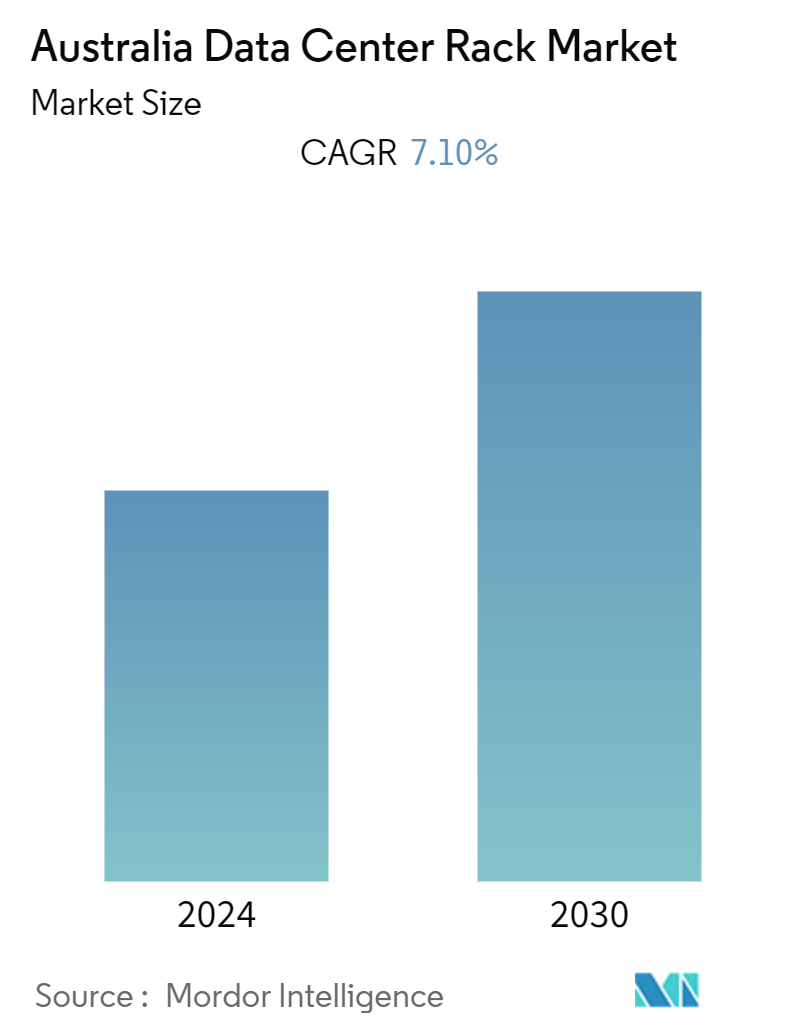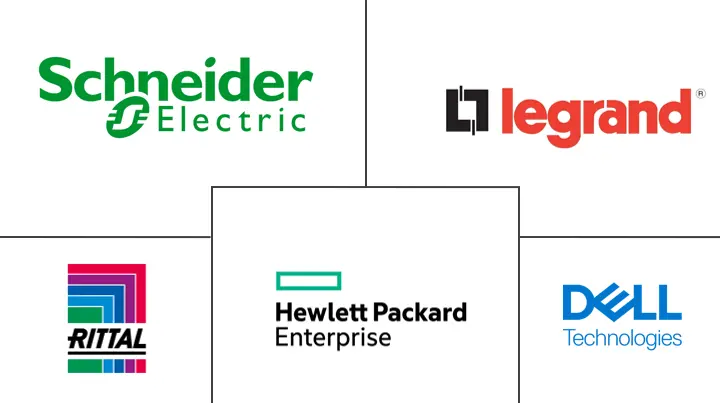Market Size of Australia Data Center Rack Industry

| Study Period | 2024 - 2030 |
| Base Year For Estimation | 2023 |
| Forecast Data Period | 2024 - 2030 |
| Historical Data Period | |
| CAGR (2024 - 2030) | 7.10 % |
| Market Concentration | High |
Major Players
*Disclaimer: Major Players sorted in no particular order |
Australia Data Center Rack Market Analysis
The Australia Data Center Rack Market is expected to register a CAGR of 7.10% during the forecast period.
The Australian data center rack market value was USD 1.7 million in the previous year, and it is further projected to grow and register to register a CAGR of 7.1%.
- The IT load capacity in the country is expected to reach over 3,000 MW by 2029, positively impacting the demand for racks in the forecast period.
- The construction of a raised floor area for data centers in the country is expected to reach 11.4 million sq. ft by 2029.
- The country's total number of racks to be installed is expected to reach over 550,000 units by 2029.
- Currently, four submarine cable projects are under construction in the country. One such submarine cable, estimated to start service in 2025, is Asia Connect Cable-1 (ACC-1), stretching over Asia Connect Cable-1 (ACC-1) kilometers with landing points Asia Connect Cable-1 (ACC-1) for planned submarine cables.
Australia Data Center Rack Industry Segmentation
A data center rack is a physical enclosure made up of the usual steel housing electronic framework. It is designed to house servers, networking and communication devices, cables, and other data center computing peripherals.
The Australian data center rack market is segmented by rack size (quarter rack, half rack, and full rack) and end-user industry (BFSI, IT, telecom, government, media, and entertainment). The market sizes and forecasts are provided in terms of volume (units) for all the above segments.
| By Rack Size | |
| Quarter Rack | |
| Half Rack | |
| Full Rack |
| By End User | |
| IT & Telecommunication | |
| BFSI | |
| Government | |
| Media & Entertainment | |
| Other End Users |
Australia Data Center Rack Market Size Summary
The Australian data center rack market is poised for significant growth, driven by the increasing demand for IT infrastructure and services. As the country expands its telecommunications capabilities, particularly with the rollout of 5G, the need for robust data center solutions is becoming more pronounced. The market is characterized by a shift towards fully configured data centers, which are essential for managing the burgeoning data generated by sectors such as telecommunications, media, and entertainment. This trend is further supported by substantial investments in mega and massive data centers, which are expected to dominate the market landscape. The presence of major players like Rittal GMBH & Co.KG, Schneider Electric SE, and Dell Inc. underscores the competitive nature of the market, as these companies continue to innovate and expand their offerings to meet the evolving needs of Australian businesses.
The market's growth trajectory is also influenced by the strategic developments within the telecommunications sector, where companies like Telstra, Optus, and TPG are enhancing their infrastructure to support advanced 5G services. The acquisition of telecommunication tower assets by OMERS Infrastructure highlights the increasing convergence of telecom and data center operations. Additionally, the construction of new data centers, such as NEXTDC's Melbourne facility, reflects the growing demand for high-capacity racks to support cloud computing and big data analytics. As companies increasingly rely on data centers for efficient data management, the market is expected to see a rise in the deployment of full racks, catering to the needs of various industries. This dynamic environment presents ample opportunities for vendors to capitalize on the expanding market potential.
Australia Data Center Rack Market Size - Table of Contents
-
1. Market Dynamics
-
1.1 Market Overview
-
1.2 Market Drivers
-
1.2.1 Increasing Deployment of Data Center Facilities
-
1.2.2 Growing Cloud Computing Adoption Leading to Investment in Hyperscale Data Centers
-
1.2.3 BFSI Sector Expected to Hold a Significant Share
-
-
1.3 Market Restraints
-
1.3.1 Increasing Utilization of Blade Servers
-
-
1.4 Value Chain / Supply Chain Analysis
-
1.5 Industry Attractiveness - Porter's Five Forces Analysis
-
1.5.1 Bargaining Power of Buyers/Consumers
-
1.5.2 Bargaining Power of Suppliers
-
1.5.3 Threat of New Entrants
-
1.5.4 Threat of Substitute Products
-
1.5.5 Intensity of Competitive Rivalry
-
-
1.6 Assessment of COVID-19 Impact
-
-
2. MARKET SEGMENTATION
-
2.1 By Rack Size
-
2.1.1 Quarter Rack
-
2.1.2 Half Rack
-
2.1.3 Full Rack
-
-
2.2 By End User
-
2.2.1 IT & Telecommunication
-
2.2.2 BFSI
-
2.2.3 Government
-
2.2.4 Media & Entertainment
-
2.2.5 Other End Users
-
-
Australia Data Center Rack Market Size FAQs
What is the current Australia Data Center Rack Market size?
The Australia Data Center Rack Market is projected to register a CAGR of 7.10% during the forecast period (2024-2030)
Who are the key players in Australia Data Center Rack Market?
Rittal GMBH & Co.KG, Schneider Electric SE, Legrand SA, Dell Inc. and Hewlett Packard Enterprise are the major companies operating in the Australia Data Center Rack Market.

